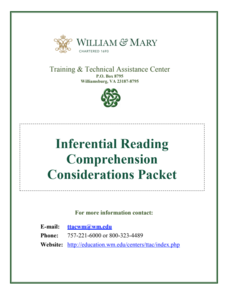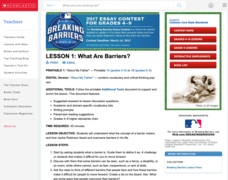Poetry4kids
Simile and Metaphor Lesson Plan
Similes and metaphors are the focus of a poetry lesson complete with two exercises. Scholars read poetry excerpts, underline comparative phrases, then identify whether it contains a simile or metaphor. They then write five similes and...
William & Mary
Inferential Reading Comprehension Considerations Packet
Don't forget to read between the lines! Educators learn tips and activities to help scholars learn to infer to increase reading comprehension. Activities suggested include think alouds, backwards words, and who's who. the packet includes...
Education.com
St. Patrick's Day Writing: If I Found a Pot of Gold...
This St. Patrick's Day, young writers imagine they found a pot of gold at the end of a rainbow. After a class discussion and brainstorming, scholars compose a narrative essay making sure they incorporate transitions and at least three...
Canada's National Arts Center
Vivaldi and The Four Seasons
Did you know that Vivaldi’s orchestra was largely made up of girls from an orphanage? Fun facts like this fill a 34-page teacher's kit designed to accompany a cross-curricular study of Vivaldi's The Four Seasons.
K12 Reader
Mild and Strong Interjections
Whew! This worksheet is tough! Unless, of course, young grammarians know the difference between mild and strong interjections.
K12 Reader
Interjections in Dialogue: Tom Sawyer
Mark Twain is a master of using interjections in his dialogue. A grammar worksheet focused on interjections features the passage from The Adventures of Tom Sawyer in which Tom tricks Ben into taking on the job of whitewashing Aunt...
K12 Reader
Find the Interjection
Yikes! Young grammar sleuths must find the interjections that add the oomph to a series of sentences.
K12 Reader
Add an Interjection
Wow! Here's a activity about interjections! After reading a brief definition of this part of speech, young grammarians select an interjection from the provided word bank to add to a sentence.
K12 Reader
Correcting Run-On Sentences: Commas and Conjunctions
Young grammarians learn how to correct run-on sentences by adding coordinating conjunctions and commas.
K12 Reader
Writing with Subordinating Conjunctions
Challenge young grammarians to turn sets of phrases into sentences by adding subordinating conjunctions on a short activity.
Literacy Volunteers of Greater Hartford
Similes Activity using Jazz (featuring Duke Ellington)
Language learners get into the swing of things with a jazzy lesson about similes. They read an article about Duke Ellington, listen to samples of his music, and then try their hand at crafting similes to describe his improvisational and...
Newsela
Mexico: Art, Food and Culture
What can we pick up from the culture of others? Scholars learn much about people of Mexico by completing a close reading of articles about the country's culture. After completing the selection, readers carry out tasks, complete quizzes,...
Scholastic
Lesson 3: Essay Organizer
A three-minute exercise warms-up scholars' writing abilities in order to follow a writing process that ends in an essay. The essay's topic is a barrier and the values used to break it. Four steps include choosing a topic, jotting-down a...
Scholastic
Lesson 1: What Are Barriers?
Scholars discuss the concept of a barrier with a short passage on Jackie Robinson. The writing process begins with a paragraph and several other sentences about Robinson's unique traits that made breaking a barrier possible.
Scholastic
Jackie Robinson
Learners complete a six-page coloring book featuring Major League Baseball's first African American player, Jackie Robinson. To bring the pages to life, scholars follow directions adding color and pictures where directed.
UnboundEd Learning
Rosa Parks: The Mother of the Civil Rights Movement
Class members listen to a passage on Rosa Parks, examine images of the Montgomery Bus Boycott, and respond to questions based on the text. They then craft a free-verse poem that recounts her achievements and reveals why she is considered...
Education World
Remembering Jackie Robinson
A four-paragraph informational text details the life of the famous baseball player, Jackie Robinson. A prompt challenges scholars to write or discuss a time in their life when they were not included and how that made them feel.
National Park Service
The Young Naturalist
Beginning with a brief history of our 26th president, Theodore Roosevelt, then followed by a discussion of his interest in nature, young scientists take to the outdoors to locate and observe local plants and insects. Scholars return to...
Core Knowledge Foundation
Ray Charles
Introduce young learners to the read-aloud process with a short biographical passage about Ray Charles. After listening to the passage, class members respond to factual, inferential, and evaluative questions, and then create a timeline...
Smithsonian Institution
Our Story: Duke Ellington and Jazz
Get parents or guardians into the swing of things with a jazzy homework assignment. A detailed six-page guide provides before, during, and after reading suggestions for Duke Ellington: The Piano Prince and His Orchestra, Andrea Davis...
ReadWriteThink
Word Recognition Strategies Using Nursery Rhymes
As a class, scholars read the poems, Humpty Dumpty, Peter, Peter, Pumpkin Eater, and Jack and Jill, in order to identify words with the same ending sound. Using their rhyming skills, learners brainstorm additional words from word...
Meadows Center for Preventing Educational Risk, University of Texas at Austin
Lesson 16 - Adding Vowel Suffixes to CVC and Silent E Base Words
There's a big difference between hoping and hopping. A lesson on adding vowel suffixes discusses when to double a consonant before adding a suffix such as -ed or -ing. Readers practice breaking down words into syllables and creating new...
Meadows Center for Preventing Educational Risk, University of Texas at Austin
Lesson 15 - Soft G and Soft C
The names Cindy and Carrie start with the same letter, but have very different sounds. The 15th of 17 word recognition lessons focuses on the soft C sound found in Cindy and the soft G sound found in Gene. Direct instruction starts with...
Meadows Center for Preventing Educational Risk, University of Texas at Austin
Lesson 1 - Short Vowels
Apple, Adam, and At all have something in common. What is it? They all start with the short A sound. The first lesson plan of set in the Word Recognition and Fluency series introduces readers to short vowel sounds with a series of...

























